How to Start Travel Business in One Day With Tourism Website?
- What Does Every Traveling Business Need?
- Travel Agency: To Do or not to Do?
- Internet-only Travel Websites
- How to Create a Travel Website?
- What Features Will Make Your Travel Website Efficient?
- Example Tourism Websites
- Conclusion
I bet your parents were saving money for years to buy a house. And then they were saving to buy a car. And then to repair the house and replace the wallpaper. I know your parents did those things because my own did. And what about you? I, personally, don’t keep the money for something solid (for some property), but for a new experience. I prefer to go somewhere and feel something new than buying something that will demand a few years of harsh austerity.
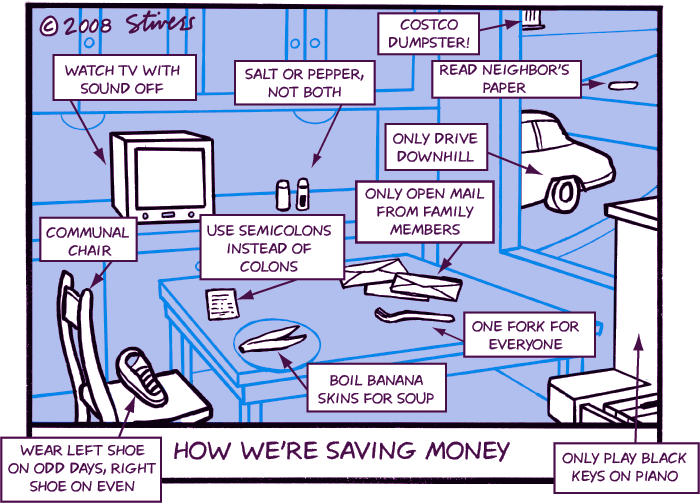
Some research, made by Gfk market research institute, says, that I’m not the only one whose intangible priorities topped the material ones. All the Millennials tend to spend money on traveling and discovering the world instead of having a car or a flat (don’t get me wrong, I would like to have them, but that is not my #1 priority). Now, when lots of people can work remotely, stable work and a personal family nest are not the future we dream of. Now we dream of working from a little hotel somewhere in the tropics and swimming in the ocean when our working day is over.
The nomadic essence of modern young society causes extraordinary boom of traveling during the last few years. That means that traveling agencies and tourism websites flourish and are more profitable than ever. If you are searching for a good startup idea, don’t miss traveling business. Though there is a fierce competition, it is a real gold mine. Besides that, you won’t need a big budget to start a travel business. So, let’s take a closer look at how to make it rock.
What Does Every Traveling Business Need?
Let’s start from the beginning. Every business (not only tourism) starts from two common steps: writing a business plan and defying brand's original niche. Those two points lay in the basics of success and are some spine of your project.
Business Plan
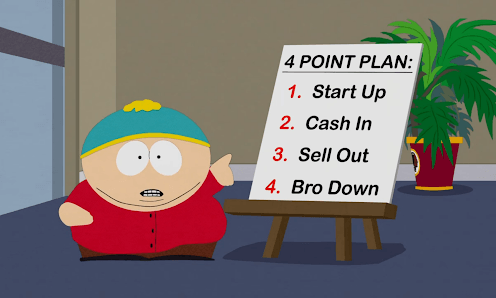
It will be tough to check your progress if there are no checkpoints. What are you planning to do, in what terms, how much money do you want to spend and then to earn? Your business plan has to answer that questions in an understandable language. Make sure that your plan has attainable milestones (no, you won’t be able to start earning a million bucks by the end of first quarter, it is possible only in your dreams). Going through the plan will also help you to monitor your achievements (or failures, but I hope you won’t meet them).
Original Idea
First, you have to do some market research. What do consumers need, and, what is more important, which ones of their needs are not yet fulfilled? If you fill that gap, you will succeed. For example, a vampire theme may become popular, but no one will do the tours in vampire castles. If you will, it will be popular, and you’ll get a significant revenue. It is a simple example, but you got the point. Give people what they want, and they will gladly pay you for that.
Travel Agency: To Do or not to Do?

When talking about travel business the first thing that comes to mind is a travel agency. You go there, and a lovely lady (or a polite man) helps you to choose a tour. The agency buys your ticket, books the hotel, provides you entertainment, excursions, and meals. You don’t have to do anything, only pay the money and have great vacations.
If you do the right advertising and create a supporting travel agency website, you will have a profitable business, but the start won’t be easy. Renting a building, hiring staff, buying furniture and other accessories – you will need a sufficient budget. And there would be a lot of efforts on building the tours, negotiating with hotels and restaurants and dealing with visas.
However, there is another way. You can create a tourism business without any starting budget at all. Of course, I mean an internet-only project, such as travel aggregator or travel blog. You won’t need a single dollar to start one of these, and you will be able to launch your website in a few hours. Let’s look more deeply into them.
Internet-only Travel Websites
Millennials don’t like to use travel agencies and prefer to create the route by themselves. It is more exciting and adventurous to go to some rarely visited by tourists’ town, live in a small cosy hotel and see the natives culture and habits without shouting ads and tedious excursions. Websites that could help to plan the journey or give good advice about destination became popular (and profitable, yes).
Traveling Blogs
If your hobby brings you enough money for the living – you are a fortunate man (or woman). I think anyone dreams to have that kind of job while reading travelers blogs. Going to some exciting and beautiful places, take pictures, discover something new, meet interesting people and get money for all that fun – you would like to live that kind of life too, don’t you?
However, every job has its “dark side.” Readers can’t see the hours of hard work that is behind the scene. Personal travel blog needs a lot of efforts and inspiration. You have to go to places no one else has been before or write about those sides of commonly known attractions no one ever mentioned. It could be exhausting.
Despite travel blogging is not an easy job, there is simply no reason for you to give up the idea without trying. traveling blogs need content, so start writing. It doesn’t matter if you currently work on a stable job and sit in one city. Write down the stories that happened with you on vacation or describe some interesting places of your town. Your stories have to be interesting or useful for people to read them, so go find your own “voice”. It could be a long way to start monetizing your blog, but if that is your dream - stop thinking “how to start a travel blog?” and start to write something. A road in one hundred miles starts from a first step, you know.

Travel Aggregators
When you are planning a journey there’s a lot of problems you have to solve (as long as you decided where you want to go after reading someone’s traveling blog). In a search for the cheapest tickets and hotel rooms, you would have to open dozens of websites and compare the prices. Travel aggregators replace that bunch of pages you have to go through. The data from best travel agency websites, hotel, airline and railway pages is gathered on the aggregator. When you need to check the travel route you chose for your journey, that website checks all the websites somehow connected with your desires and gives you a concise and sound report. It is very convenient and that’s why aggregators are popular now. Actually, creating the travel aggregator website is the easiest way to start the travel business.
How to Create a Travel Website?
Professionals always make the best things. If your budget is big enough or you want an original website, you have to hire a web developer. Unique sites are carefully built from scratch to fit every client’s needs and wishes. It will take time, and it will be expensive, but that would be a real masterpiece.
However, since you are reading this, I don’t think you have an unlimited budget to spend on a website designing. If a question “How to create a travel blog?” (that’s an example, I’m not sure what kind of travel website you would like to build) is already spinning in your head – you’re lucky because I’m going to talk about it in greater detail.
Traveling Blog on WordPress
WordPress is a platform that was created for blogging. When the time passed, it expanded functionality, but it is still the best CMS to build a blog. More than a half of all travel blog sites are made on WordPress, and you know what? They’re awesome. Besides that, you will have no problems with installation and further customization. Even if a question occurs, the WordPress community is huge; there are hundreds of guides and forums about it so that you get all necessary help and support. And the most important WordPress advantage are plugins. When the time will come to start monetizing your blog the plugins allow you to add any functionality needed.
The process of creating a personal travel blog on WordPress is not long, but some guidance would be helpful. You will have to choose a domain name, get a hosting, install WordPress and do the customization. For your convenience, we gathered all the necessary information to an eBook called “How To Create a Travel Affiliate Website”. It starts from the beginning and leads you through the WordPress website creation process. There also are answers to such important questions as “Who can help you with the website tuning?”, “What are the best affiliate programs?” and “How to make your travel blog popular?” It is entirely free, so don’t be shy and download it.
What Else Can We Help You With?
TemplateMonster provides help both to experienced developers and beginners for 15 years. Every day we expand the number of useful tools and improve our skills. So, by now, we have a huge bunch of items that will come in handy when you start building your travel blog or tourism website. We also have some experience we can share, so here’s some advice:
1. Use a Trustworthy Hosting
That is a place where your website will be stored, so don’t try to save every penny (if you are renting a house or a flat you probably know that it is a terrible idea to mess up with the owner). There are not expensive hostings that offer an excellent service for an acceptable price. I recommend you to try InMotion Hosting; they have hosting plans that start at only $7.99 monthly payment.
2. Search for Travel Website Templates
Professionally created templates let you avoid a bunch of issues. Instead of building the design from scratch you can take a look at the ready-made variants, choose one and then customize it a little. A template sufficiently reduces the time you will need to launch your website and makes it much easier. Of course, you can find free themes almost in every marketplace. Their functionality is a little reduced, but they still are professionally built and has a cool design. However, I don’t suggest you do it. Paid template pack includes a lot of additional stuff, that is very useful both for beginners and experienced users.
Take look at the OnVacation travel company theme. It is one of the best TemplateMonster’s travel templates and it was built with great care and love. We take into consideration all the freshest trends and used them to make an up-to-date and fancy theme. It is completely responsive and any of its parts, from the attractive slider on the top, to the contact information on the footer, will look perfect on any type of screen.
The template is compatible with Elementor page builder, which gives you an opportunity to customize every detail on the page without going to the administrative dashboard. There are a few Jet plugins, included to the template pack, that sufficiently expand the number of available tools and help you to add some attractive blocks to the website.
The theme has little animation effects, picked and used with great taste. There’s always a seduction to use hover animation on every tile, but that will only make the website messier. In OnVacation template there’s only parallax, a counter and some modest hover tiles shadowing. It helps to highlight some parts of the page and make a nice accent on them. If you are going to create a travel blog or any other type of tourism website – this template will be a great solution and a convenient tool.
3. Don’t Hesitate to Ask for Help
We can’t be brilliant in everything. People are generally good in a particular set of activities (except Elon Musk, he is a genius in everything). If at some point you will feel that you’re stuck – ask for help. TM Service Center could help you at every step of the website creation process and even can do everything for you. You don’t have to abandon the whole project; the issue could be smaller than you think.
Additional Stuff
Premium travel website templates are undoubtedly better than free ones. You can start with a free template, but when your travel blog starts to bring you money, it will be better to get yourself a professional, paid theme. By that time, you won’t be a beginner anymore, so it will be suitable to become more solid. As we were talking about WordPress templates, check out this dynamite 35 top-rated travel themes.
We gathered the most popular trends of 2018 there.
To make everything in your website work correctly, you will need plugins, and you definitely should download the Hotel Booking Engine WordPress Plugin. It is useful for a blog, but a travel aggregator won’t get along without it. The plugin helps your visitors to make the booking of the hotel or rent a flat and is compatible with Booking.com, Airbnb, and TripAdvisor.
What Features Will Make Your Travel Website Efficient?
After going through dozens of travel websites, I noticed that they rarely learn from each other. A couple of times while scrolling the site I was thinking: “It would’ve been great to add a map here, as they do in the previous website” or “They need a calendar, I saw a very convenient one on the other site.” That is a significant observation – learn from your competitors. Always try to make your website better and users will appreciate it. I gathered a list of travel websites most useful functionalities. Not all of them will fit you (pricing plugin would be redundant on a travel blog websites), but while going through it, you can catch some inspiration and improve your own creation.
Search Filters
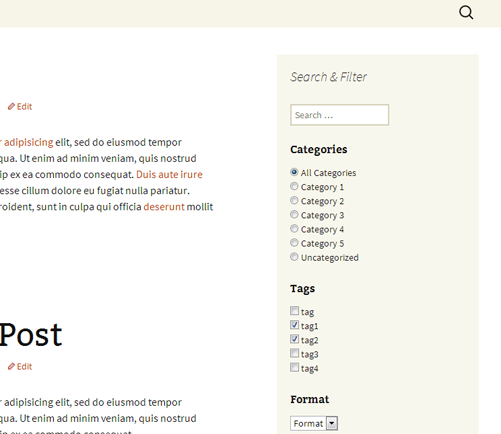
When you have some concrete criteria for a search, it is very convenient to filter the results. You can tick some boxes and get what you want faster and more specifically. Despite it makes using the travel website more pleasant, few of them have it. If you create a travel aggregator or a travel agency website, it will be great for you to use it. A free plugin that helps to add search filters is called Search & Filter.
Anticipating Search

Sometimes you don’t remember the exact name of a city you want to go to. Was it “Warsaw” or “Warshaw” or what? The predictive search will help a visitor with such a problem. The plugin tries to predict what do you want to find and gives you several variants. Both personal travel blogs and tourism websites would become more convenient with it. Ajax Search Lite is a great plugin to add an anticipating search to your site.
Reviews and Ratings
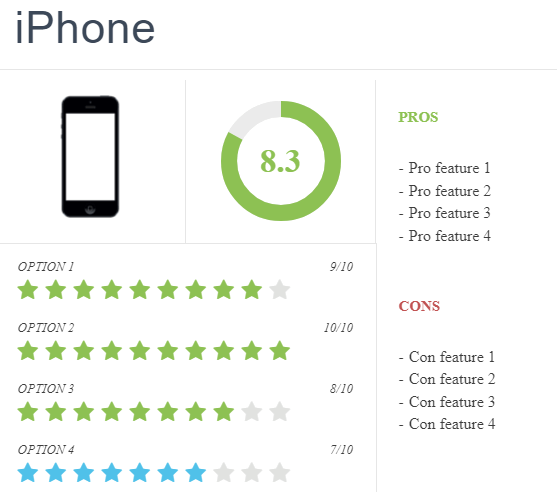
I bet you look through customers’ reviews when buying something. People always want to know what other customers think of the product they already bought. That’s why you should add reviews and rating functionality to your travel website and encourage visitors to leave comments – it will increase your site’s trust rate. WP Product Review Lite is an excellent plugin to help you with that.
“Add to Favorite” Button
A list of destination that you liked (but not sure you want to go there) is a super convenient thing. You can wander through the site and go to the list you considered interesting, to choose a final variant. The free plugin that will help you to add that functionality to your travel agency website or travel aggregator is Favorites.
Google Maps

Travel agency website or a travel aggregator often have maps, but they are not useful and convenient. Add functionality that would show visitors not only a mark on a map but a picture, description, and links too. WP Google Maps is a simple and free plugin that will help you with that.
And here’s some additional advice:
- Mobile friendly website. It could sound strange, but lots of travel websites don’t have a responsive mobile version. Anyone who ever tried to use such a site from a smartphone will understand my pain. Don’t make that mistake, make sure your visitors won’t have any problems reading your travel blog or visiting tourism website from their mobiles.
- Huge and sharp pictures. People like images, especially if they are professionally shot and look gorgeous. I’m not telling you to hire a cool photographer to take photos but to pay attention to what you put on your website. Either a travel blog or a travel agency website has to have eye-catching images.
- Vibrant copy. Nobody will read a dull and boring description. If you can’t write an exciting and intriguing text, don’t do it all. If you have a travel aggregator website, hire a professional copywriter (if you were going to create a travel blog and you can’t write a vivid and witty text, I have bad news for you).
Example Tourism Websites
It could be challenging to think of your travel website design. What to put on the top of a page? How many pictures to use? What information to give? If you are a beginner, these questions could make you stuck. A few examples can give you some inspiration and a good hint about where to move further. I gathered best travel blogs, tourism and travel agency websites (in my opinion, of course) to help you focus and learn from those who already succeed.
Best Travel Agency Websites
Visit Brazil
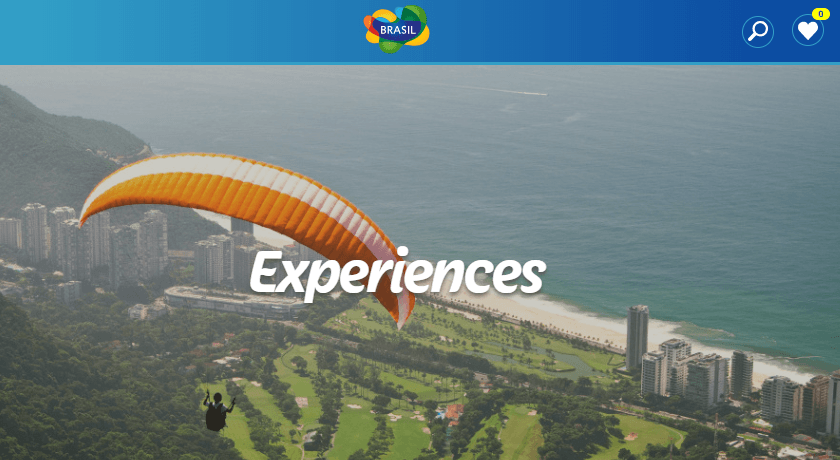
It is a Brazil’s official tourism website, and it is made according to all the rules. A big, gorgeous photo on the top, lots of nicely structured information, all the categories are intuitively understandable. The whole country is divided into smaller pieces, to make it easier for the visitor to find something interesting. This website really “sells” Brazil as a tourism destination.
On the Grid

This website has an original structure. There are no longreads there, only short, laconic descriptions of places, restaurants, galleries, trading centers. The user can choose a continent, and the website will show all the cities of that region. After clicking on the city, a user can choose a neighborhood (like a region of the city) and go through everything that interests him, like places to eat, to live and to entertain himself.
Toucan Café & Tours
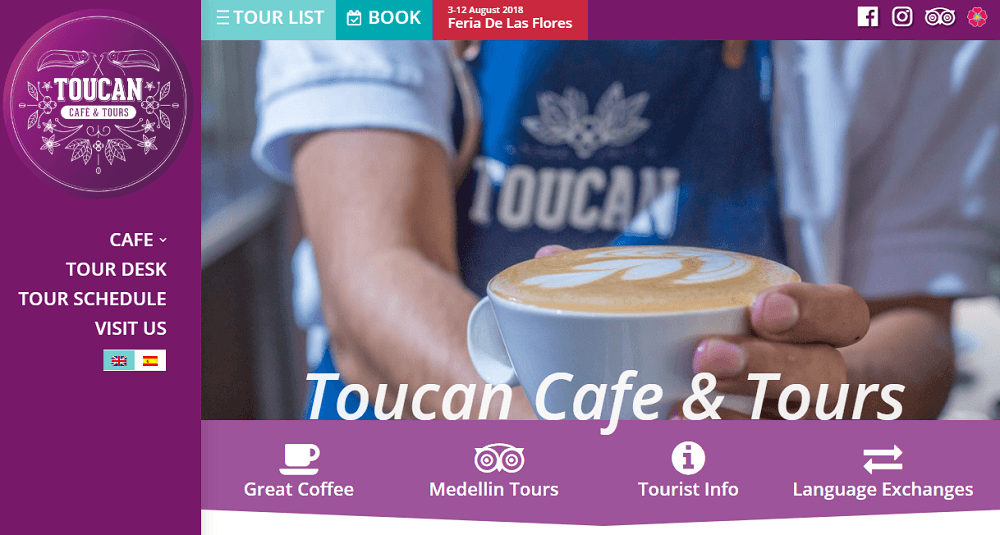
This coffee shop not only sells coffee and has a café, but also do tours. The website is simple but has everything necessary: lovely big photos, well-structured schedule and understandable categories. It is easy to find anything you seek. Try to make your own website simple and convenient for users.
Travel Oregon
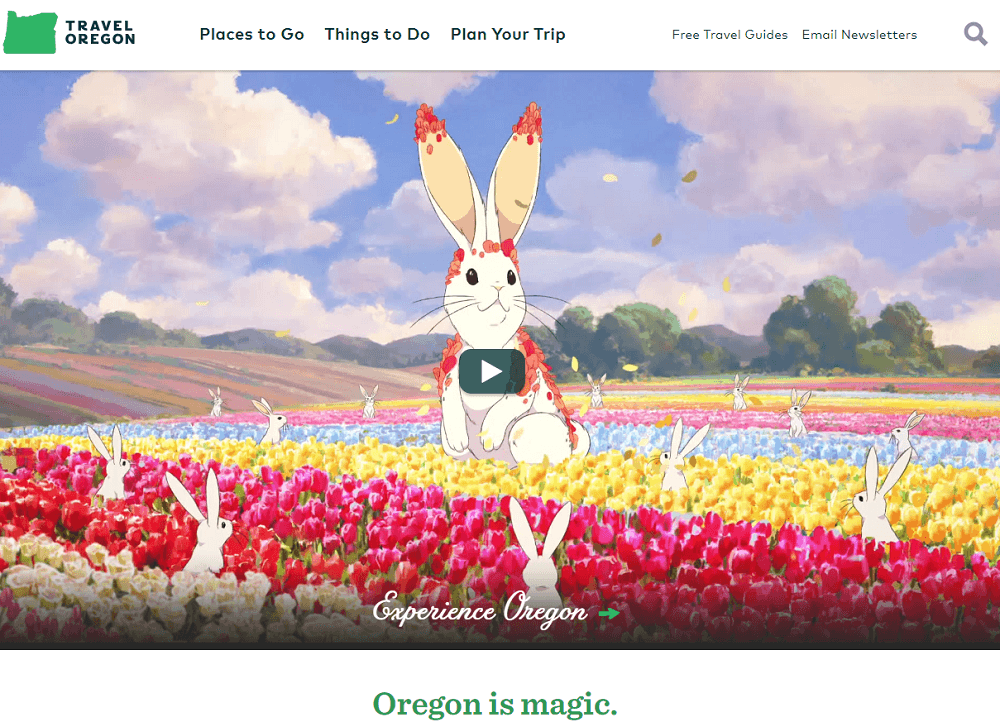
As you can understand from the name, this one is Oregon State tourism website. Its main idea is simple: “Oregon is magic.” To make a visitor feel that magic there’s a Ghibli studio-like cartoon on the top of the screen. And it works. I start wanting to go to Oregon from the first seconds of that video, and I think other viewers feel the same. Evoking an emotional response from the visitor is a key to travel business success.
African Budget Safaris
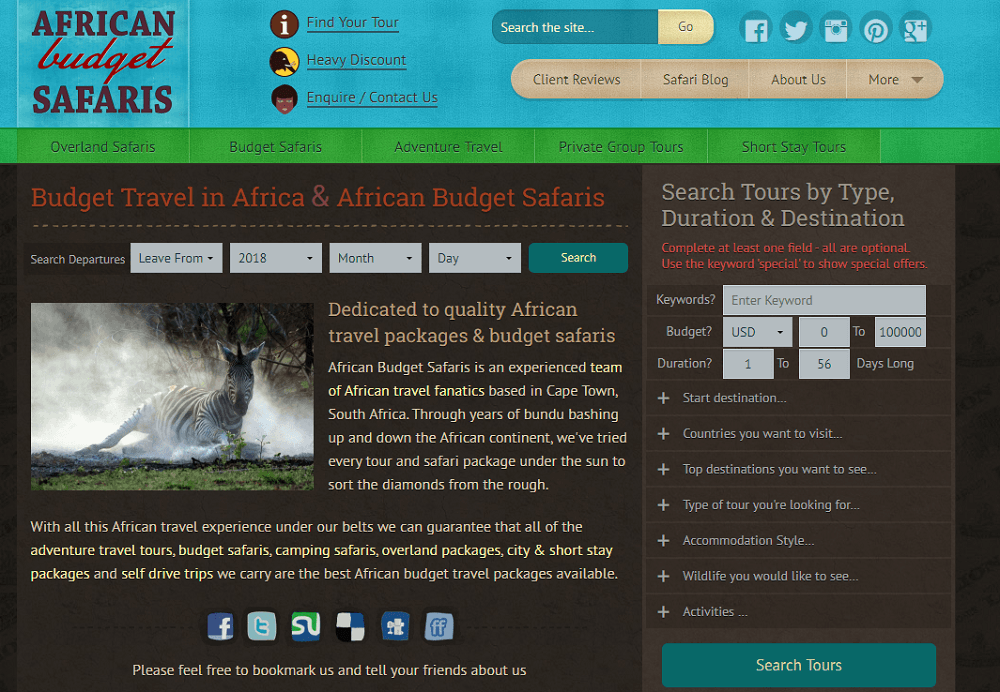
That website fits its main idea for 100%. It helps customers find cheap safaris. The design is not that stylish as the previous websites have and there are no big, eye-catching photos. But there is information a user needs and it is easy to reach, so the website does it job perfectly.
Mount Kilimanjaro Guide
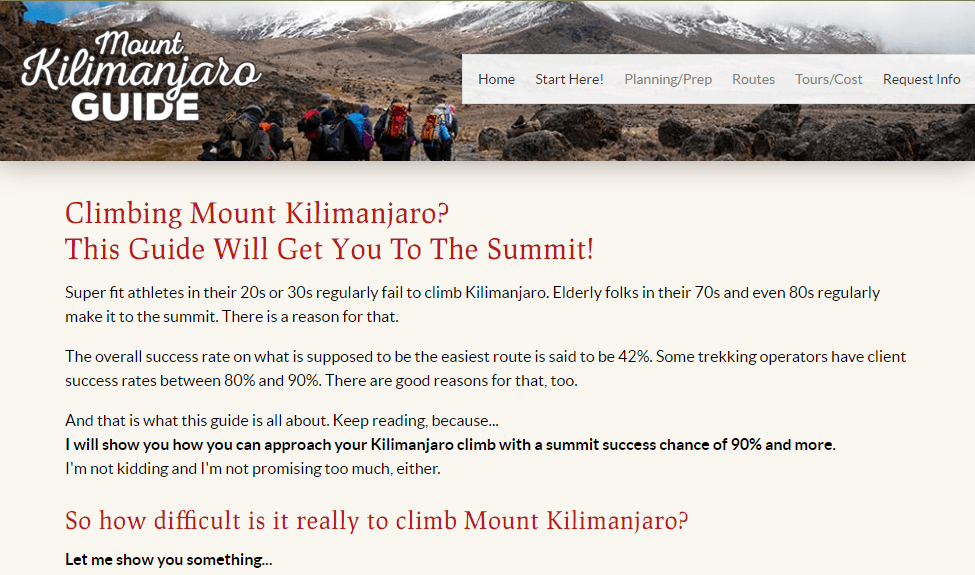
It looks like this tourism website violates all the rules of successful travel site. No divine, large pictures, and the homepage starts with a text. However, this travel website is top-rated. Why? Because it is not for those who are not sure if they want to go to that mount. This travel website is for tourists that already wish to go and now seek some additional information. Remember that your site has to be organized correctly for your target audience, not for your aesthetic wishes (yeah, a little boring, but practical).
Best Travel Blogs
Dan Flying Solo

This guy has everything to be a popular blogger. He takes great photos, he shoots terrific videos, and he writes exciting posts. His website is well-organized and shows the best of his works first. Look at his videos for inspiration (I think lots of other bloggers try to do videos as he does, Dan is some travel videos guru).
A Broken Backpack
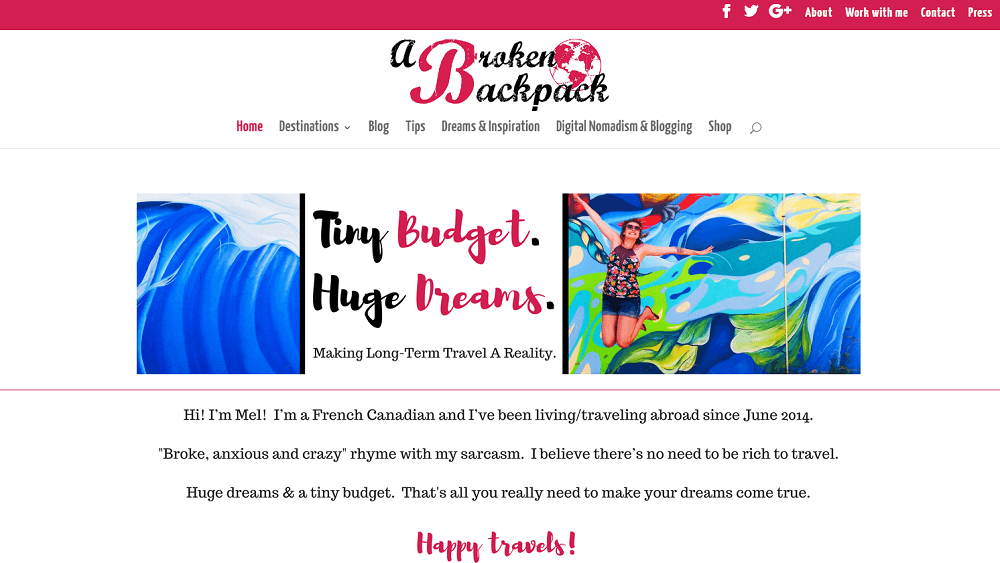
Mel claims that you don’t need to be rich to travel everywhere and shows her subscribers how. She seeks for cheap or free accommodations, gives a lot of advice how to pack, what to take to the trip and what to see. Everyone would like to go traveling not for all the money in the world, and that’s why Mel is so popular – she gives people what they want.
The Blonde Abroad
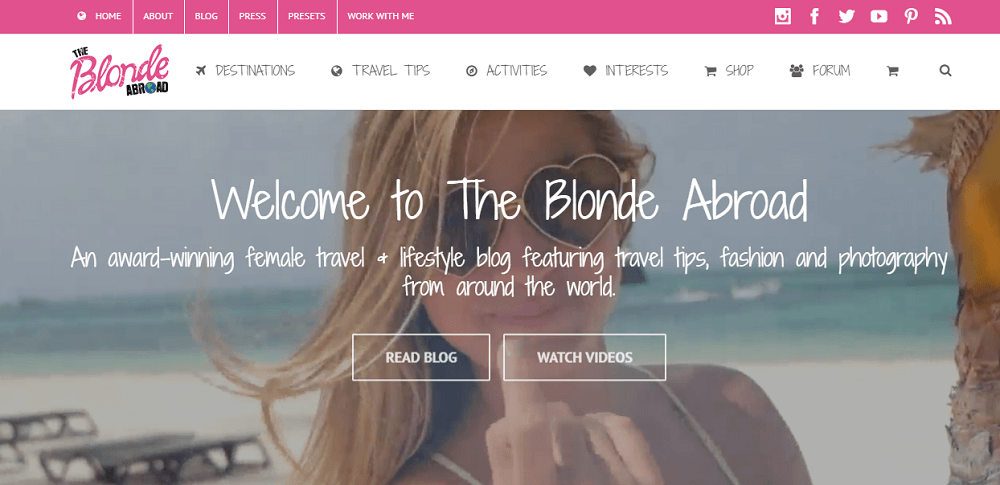
This girl uses perfectly all the stereotypes about blondes. She works with a massive bunch of cosmetics and clothes brands, does incredible photos and travels to different luxury places. Despite the stereotypes she uses, Kiersten writes witty texts, and she was working in finance before started her nomadic career.
View From the Wing

This is another specifically focused popular travel blog. The author concentrates on describing airlines services, airports, and hotels near the airports. His blog is strict and simple, but perfectly expresses the theme he is writing about.
Conclusion
As you can see, either you build a blog about traveling or a travel agency website, the creation process is the simplest part of the work you would have to do. You will need tones of enthusiasm and everyday work to make it profitable. However, it is not impossible, and almost everyone can reach the point when this business will start to bring enough money for living. So, if you always dreamed of traveling, the dream is worth any efforts. Good luck with meeting the adventures!
Did you like the article? Was there enough information for you to create a travel website? Maybe you have some useful advice or feedback? I’ll be thrilled to get some comments and improve the text, so it becomes even more useful. Please, feel free to leave your suggestions in the comment section below.

Read Also
Top-10 Travel Agency WordPress Templates In 2018
Promote Your Travel Site Efficiently: Analyze and Segment
35 Top-Rated WordPress Travel Themes For Tourism 2018
Free Set of World Cities Icons for Your Travel Agency Site
Don’t miss out these all-time favourites
- The best hosting for a WordPress website. Tap our link to get the best price on the market with 82% off. If HostPapa didn’t impress you check out other alternatives.
- Monthly SEO service and On-Page SEO - to increase your website organic traffic.
- Website Installation service - to get your template up and running within just 6 hours without hassle. No minute is wasted and the work is going.
- ONE Membership - to download unlimited number of WordPress themes, plugins, ppt and other products within one license. Since bigger is always better.
Get more to your email
Subscribe to our newsletter and access exclusive content and offers available only to MonsterPost subscribers.




Leave a Reply
You must be logged in to post a comment.